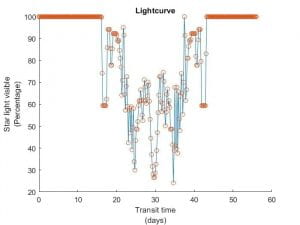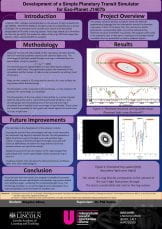By Brayden Albery //
 The aim of the project was to develop a program prototype that can simulate the orbit of a planet with a ring system passing in front of its parent star and calculate the corresponding change in visible light from the star (the light curve). The purpose of this is to continue the development of the program until it is complex enough to be used in academic research.
The aim of the project was to develop a program prototype that can simulate the orbit of a planet with a ring system passing in front of its parent star and calculate the corresponding change in visible light from the star (the light curve). The purpose of this is to continue the development of the program until it is complex enough to be used in academic research.
The simulation is currently tailored to the specifics of the V1400 Centauri star system. The star system is approximately 434 light-years away and contains an exo-planet designated J1407b. The planet is orbited by an extensive ring system that is 640 times the diameter of Saturn’s rings. The ring system was discovered in April 2007 when it passed in front of the star, blocking 95% of the light reaching Earth. The ring system has also been theorised to contain an exo-moon within it (no exo-moon have currently been discovered).
The current iteration of the program approximates the rings of J1407b as 1000-sided polygons (though this can be increased arbitrarily). Each of these rings is assigned a value from 0% to 100% of the light star passing through. The rings are then placed on a plot with the star in the centre and moved in front of the star. The area of intersection of each ring with the star is calculated and multiplied by the amount of light that the ring lets through. These values are summed for each frame and plotted against the time of transit to generate the light curve.
 The first big challenge I faced during this project was making the program able to rotate the rings at an arbitrary angle (as it is very unlikely the rings will be face-on). Rotating a circle in 3d will produce the image of a 2d ellipse, therefore the program had to be able to calculate the area of intersection of two ellipses. Unfortunately, there is no closed-form mathematical formula for this. I first tried to overcome this by saving the plots as images and calculating the brightness comparing an image of the star and the amount of ring intersection the star pixel by pixel. This was very computationally intense to the point of being unusable and did not produce accurate enough results. I solved this by instead approximating the rings as 1000-sided polygons.
The first big challenge I faced during this project was making the program able to rotate the rings at an arbitrary angle (as it is very unlikely the rings will be face-on). Rotating a circle in 3d will produce the image of a 2d ellipse, therefore the program had to be able to calculate the area of intersection of two ellipses. Unfortunately, there is no closed-form mathematical formula for this. I first tried to overcome this by saving the plots as images and calculating the brightness comparing an image of the star and the amount of ring intersection the star pixel by pixel. This was very computationally intense to the point of being unusable and did not produce accurate enough results. I solved this by instead approximating the rings as 1000-sided polygons.
The program is now at the point where it can be further built upon to include an increasing amount of the nuances of planetary transit light curve, for example taking into account how the rotation of the rings will affect the optical depth (as currently the optical depth is assumed from face-on rings).
Being a part of UROS was a great opportunity for me as it allowed me to gain hands-on experience with academic research and have a program ready to continue research in the future. I aim to use this as a stepping stone to an academic career in the future.
*To view Brayden’s research poster and presentation recording, please click on the thumbnails below: 
